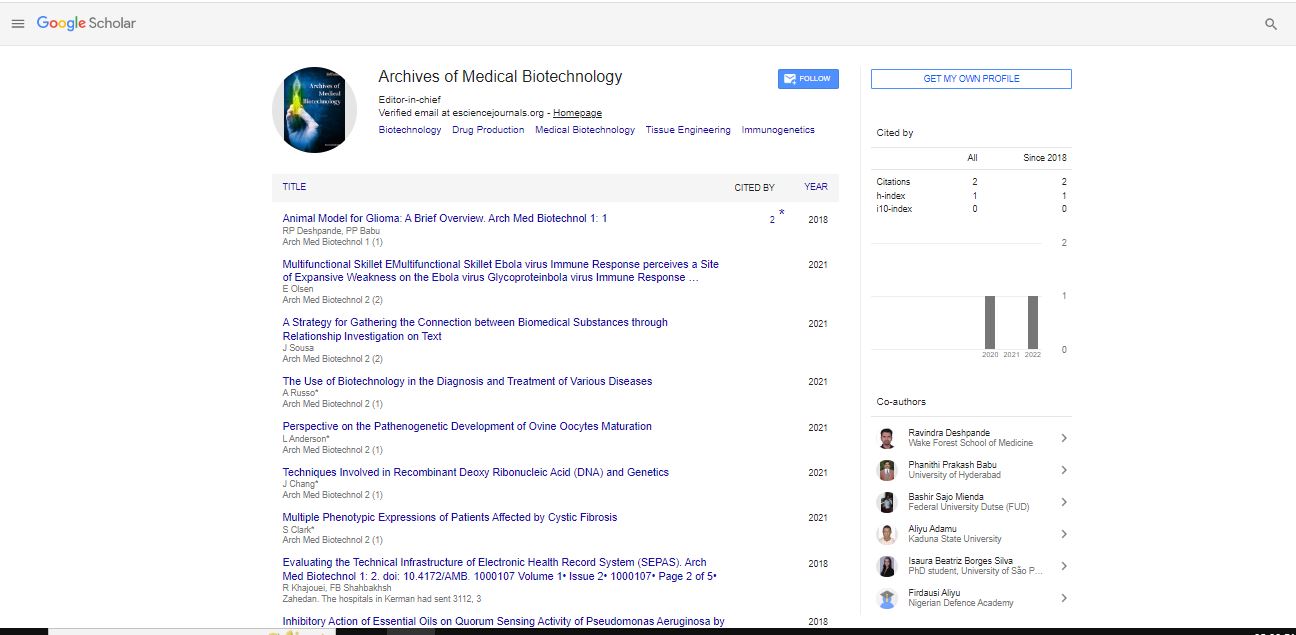Perspective, Arch Med Biotechnol Vol: 2 Issue: 1
Perspective on the Pathenogenetic Development of Ovine Oocytes Maturation
Lucas Anderson*
Department of Medical Biotechnology, School of Advanced Technologies in Medicine Shahid Beheshti University of Medical Sciences, Tehran, Iran
*Corresponding Author: Lucas Anderson
Department of Medical Biotechnology, School of Advanced Technologies in Medicine Shahid Beheshti University of Medical Sciences, Tehran, Iran
E-mail: Lucasa@pek.ir
Received: September 06, 2021 Accepted: September 20, 2021 Published: September 27, 2021
Citation: Anderson L (2021) Perspective on the Pathenogenetic Development of Ovine Oocytes Maturation. Arch Med Biotechnol 2:1.
Abstract
The point of this investigation was to think about the impact of season of parthenogenetic enactment (22 hr versus 27 hr after In Vitro Maturation-IVM) on in vitro advancement of ovine oocytes utilizing either single (Ionomycin 5 µM for 5 min or Ethanol 7% for 7 min) or consolidated (ionomycin and ethanol with 6-DMAP 2 mM for 3 hr) initiation medicines. The abattoir-inferred in vitro developed initiated oocytes were refined in altered manufactured oviductal liquid and surveyed for the cleavage, blastocyst, and bring forth rates. The single-initiated oocytes had a decrease in cleavage, blastocyst and bring forth rates contrasted with the consolidated actuated oocytes (aside from the cleavage at 27 hr). In singletreated gatherings the paces of cleavage and blastocyst were expanded as the development time was stretched out from 22 hr to 27 hr. The quantities of all out cells and Inner Cell Mass (ICM), however immaterial, were more prominent in consolidated treated gatherings contrasted with the single treatment.
Keywords: Blastocyst; Ethanol; Ionomycin; Parthenogenesis
Development of Ovine Oocytes
Oocyte enactment is one of the fundamental components that decide the accomplishment of atomic exchange and the resulting improvement of cloned undeveloped organisms. Inability to actuate oocytes productively, in a straightforward way comprises one of the restricting strides for the accomplishment of cloning by atomic exchange. Oocyte enactment permits synchronization of cell cycle stage between the cytoplasm of the oocyte and the moved core, advancing atomic reinventing and support of typical ploidy [1]. The investigation of parthenogenetic enactment likewise allows a more noteworthy comprehension of the components of unconstrained initiation, forestalling it in vitro treatment frameworks, and permits researching the near jobs of fatherly and maternal genomes in controlling early undeveloped organism advancement [2]. Fake upgrades through raising the cytoplasmic degrees of calcium particles of oocytes expect to mirror the activity of sperm cells during treatment [3]. Some counterfeit initiation medicines advance an expansion in intracellular free calcium focuses by the arrival of calcium from cytoplasmic stores, like Strontium [4] and Ionomycin [5] while there are components that advance convergence of calcium from the extra-cell medium, like electrical improvement. There are, in any case, components that advance the two impacts, like ethanol [5]. These medicines are normally trailed by the use of an inhibitor of protein phosphorylation (6-dimethylaminopurine; 6-DMAP) which forestalls Maturation Promoting Factor (MPF) initiation or an inhibitor of protein blend (cycloheximide, CHX) that forestalls cyclin union [6]. Among the inadequacies during the time spent fake actuation, the period of oocyte (development time) could be a significant contributing component. Actuation is all the more effectively accomplished in matured oocytes because of the unconstrained decrease on MPF movement with maturing of oocytes and changes in affectability of metaphase II (MII) oocytes to the inside calcium irritation incited by a counterfeit boost. Notwithstanding, it is realized that such maturing, aside from its negative cytoplasmic changes, causes adjustments in segments of the cytoskeleton of the oocyte, weakens enucleation through changes in the area and association of the second meiotic shaft influences undeveloped improvement after combination and expands the recurrence of discontinuity and caspases initiation, liable for cell apoptosis . In this unique situation, reliance on oocyte age for parthenogenetic enactment can be limited by advancement of various intracellular calcium beats or mix of various fake initiation medicines. In certain species the reaction of youthful oocytes to parthenogenetic initiation is low and matured oocytes are regularly utilized as beneficiary oocytes for atomic exchange of undeveloped cores. The capability of matured mouse and hare NT oocytes getting early stage cores to form into blastocyst is higher than that of youthful oocytes. Interestingly, there are reports showing the lower formative capability of matured ox-like and mouse oocytes after parthenogenetic initiation contrasted with the youthful oocytes. Albeit an age-subordinate initiation reaction has been portrayed beforehand in a few animal varieties, including the mouse cow and pig, there are no important investigations on the impact of oocyte age on parthenogenetic actuation in sheep. In the current investigation, as an essential evenhanded, the impact of development time of ovine oocytes on efficiency of actuation medicines, and as an auxiliary target the correlation between the impact of single or consolidated initiation medicines on ovine parthenogenesis were assessed. In this assessment, the cleavage and blastocyst rates, the limit of the blastocyst to bring forth from the zona pellucida, blastocyst cell numbers and the phone portion were investigated.
References
- Yazawa S, Aoyagi Y, Konishi M, Takedomi T (1997) Characterization and cytogenetic analysis of Japanese Black calves produced by nuclear transfer. Theriogenol 48(4): 641-650.
- Barnes FL, Maiki-Laurila M, First NL (1989) Age dependence of bovine oocyte activation. Gamete Res 22(3): 265-275.
- Tervit HR, Whittingham DG, Rowson LE (1972) Suc-cessful culture in vitro of sheep and cattle ova. J Reprod Fertil 30: 493-497.
- Juetten J, Bavister BD (1983) Effects of egg aging on in vitro fertilization and first cleavage division in the hamster. Gamete Res 8(3): 219-230.
- Lee SN, Liu BT, Chu FH (2008) The effect of activation treatments on the development of reconstructed bovine oocytes. Anim Reprod Sci 106(1-2): 1-12.
- Bonk A, Prather RS (2004) Apoptosis in parthenogenetic preimplantation porcine embryos. Biol Reprod 70(6): 1644-1649.
 Spanish
Spanish  Chinese
Chinese  Russian
Russian  German
German  French
French  Japanese
Japanese  Portuguese
Portuguese  Hindi
Hindi 